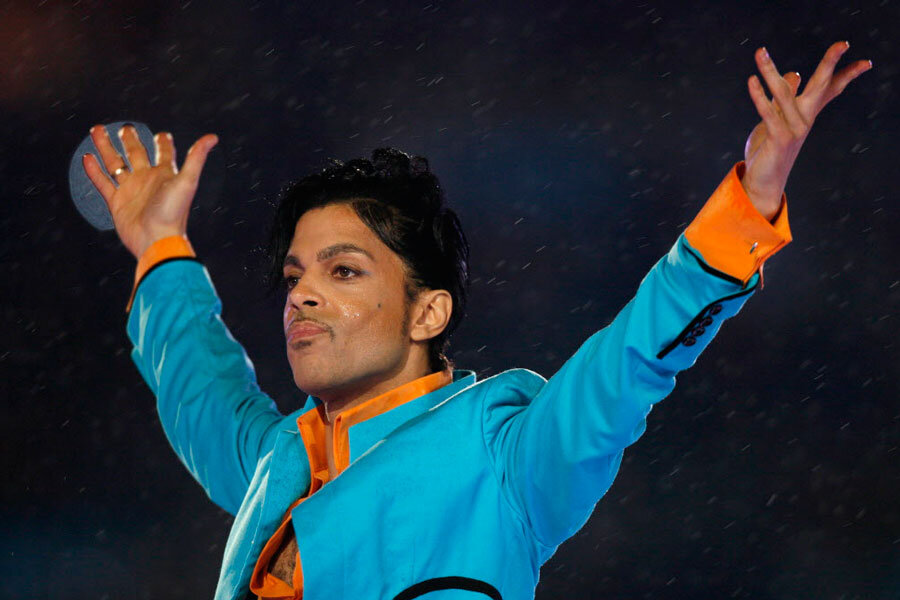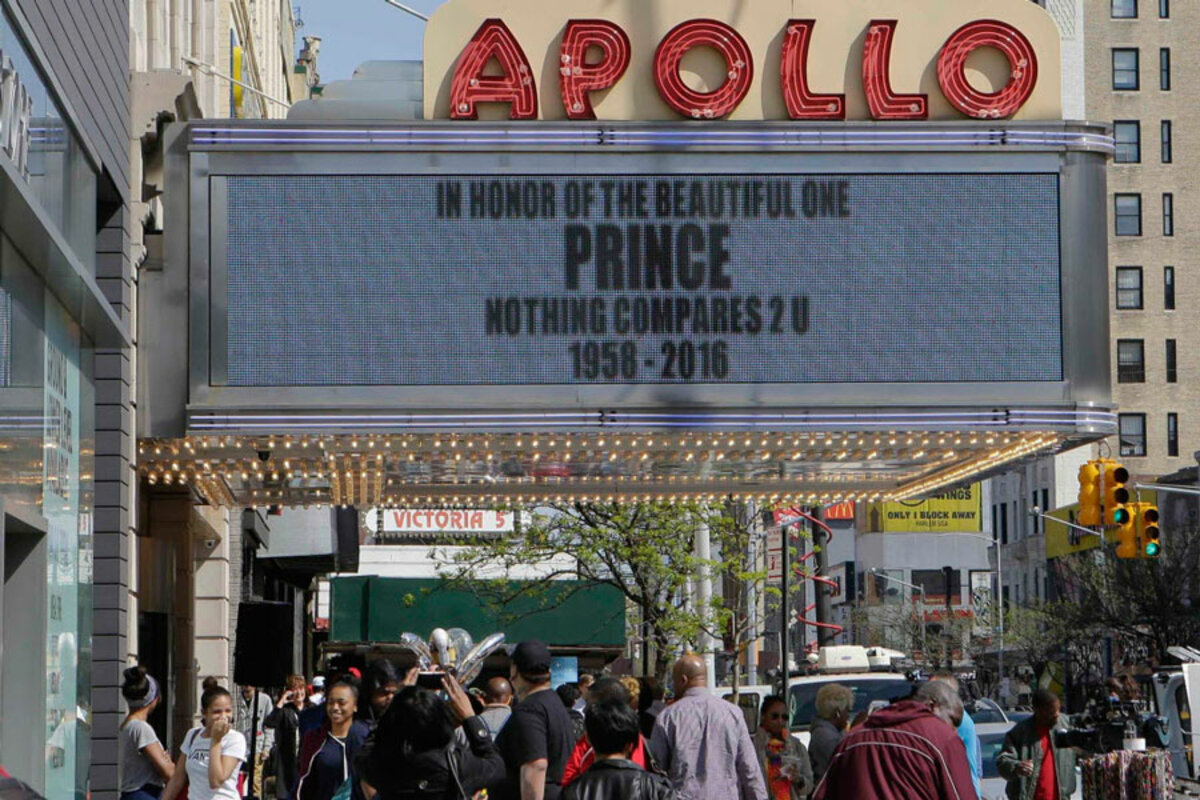In Prince, an icon who defied easy categorization
Loading...
There were the hits: “Little Red Corvette” and “Let’s Go Crazy.” There were the kohl-lined doe eyes. There were the nimble fingers cascading up and down the neck of his guitar. But perhaps the greatest legacy of pop icon Prince, who passed away on Thursday, was as a beacon of hope to all who felt judged for being different.
As he splashed onto the R&B scene in 1978, a young Prince (né Prince Rogers Nelson) presented himself as a racially ambiguous, androgynous teenager who gyrated to a thumping funk beat. He shocked parents with his explicit lyrics. He thrilled kids with his nonconformist attitude. He galvanized audiences with his show-stopping guitar playing. (He could expertly play all the other instruments, too).
But even as he swaggered seductively across stages from Topeka to Tokyo, Prince was crafting a breakthrough sound that ultimately ushered him into the Rock & Roll Hall of Fame – and challenging business as usual in a music world that often was soured by racism and sexism.
Prince was bent on nothing less than revolutionizing the music industry. It was a mission he remained true to as he made the journey from young radical to a more thoughtful and even spiritually-minded adult, as he swung between burning fame and moments of irrelevance. His impact was underscored Thursday as buildings and bridges were illuminated in purple, Prince’s trademark color, radio stations played Prince music all day long, and the likes of Paul McCartney, Madonna, and Spike Lee tweeted their sense of loss and appreciation.
Prince’s early albums – “For You,” “Prince,” “Dirty Mind” and “Controversy” – established his prurient pixie persona and funk-flavored sound. But it was “1999,” his musically groundbreaking double album of 1982, that introduced the “Minneapolis Sound” into pop culture consciousness. Marrying R&B and its many iterations with rock and roll, “1999” set the stage for Prince’s lightning-in-a-bottle crossover smash two years later, “Purple Rain.”
Defying categorization
That rock album extended Prince’s reach from largely black audiences to the white mainstream. It cast Prince in a new, racially “white” light – an ironic development, given rock’s roots in blues, traditionally “black” music. Yet the album was true to his eclectic outlook – Prince knew his history, and was steeped in styles and influences that ranged from James Brown to Jimi Hendrix to Joni Mitchell.
“Purple Rain,” which won a Grammy, also proved Prince’s interest in testing new territory. His coup was to release a companion movie of the same name, featuring himself as “The Kid” – the ultimate guitar hero, struggling to keep his band members on board his ego train. With its setting in Prince’s hometown of Minneapolis, “Purple Rain” reads as autobiographical – even though the musician’s private life remained hermetically sealed throughout his career. The music won him Original Song Score at the 1985 Academy Awards – highlighting his major contribution to mainstream pop culture.
Yet Prince intentionally defied categorization. His band was racially integrated from the start – a relatively uncommon phenomenon. Along with Michael Jackson, with whom he had a spirited rivalry, Prince brought racial diversity to MTV’s emerging format of music videos. Pop music became less stratified along racial lines as a result. He also championed female musicians in key roles (such as virtuosic percussionist Sheila E.), which went against the grain of an industry justifiably regarded as sexist.
His enthusiastic support of female musicians did not make Prince a saint: He played up their sex appeal, and not a few were romantically linked to him, following a paradigm long entrenched in the pop music patriarchy. But just seeing Wendy Melvoin rock out on guitar in “Purple Rain” felt like a revolutionary act, inspiring girls everywhere. In recent years, Prince continued his tradition of performing with female musicians with 3rdEyeGirl.
Prince was all about range, his voice swooping from a come-hither bass to a crooning falsetto on such songs as “International Lover.” He composed all his own songs and those of many other artists, including “Nothing Compares 2 U,” which Sinead O’Connor delivered so soulfully. Prince also enjoyed performing other artists’ songs that he deemed worthy, such as Amy Winehouse’s “Love is a Losing Game.”
As Prince matured and put his mark on everything from contract negotiations to merchandising, he increasingly took up the cause of self-determination for musical artists. The issues of ownership and long-term contracts were especially important to him as a black musician, part of a group he saw as having historically been cheated out of money that was rightfully theirs.
Indeed, in 1993, Prince retired his name and instead began using a glyph that combined the symbols for male and female. Dubbed “TAFKAP,” or “The Artist Formerly Known As Prince,” he began appearing in public with the word “SLAVE” written on his face in protest against his label, Warner Bros. He parted ways with the company in 1996, then struck a deal with them 18 years later to regain ownership of his catalogue.
"People think I'm a crazy fool for writing 'slave' on my face," Prince said to Rolling Stone in 1996. "But if I can't do what I want to do, what am I? When you stop a man from dreaming, he becomes a slave. That's where I was. I don't own Prince's music. If you don't own your masters, your master owns you."
'A mirror and a shaping force'
In the interim Prince released an impressive, if not financially record-breaking, slate of albums such as “Rave Un2 the Joy Fantastic.” He experimented with jazz and continued to produce albums inflected with funk and rock. His discography comprises 39 studio albums, four live albums and six compilation albums; Prince made 136 music videos.
Prince cemented his reputation as a giant among guitarists with his transcendent solo during a tribute to George Harrison on the song “While My Guitar Gently Weeps” at Prince’s induction to the Rock & Roll Hall of Fame in 2004, and brought down the house at the 2007 Super Bowl.
At his Hall of Fame induction, Prince revealed a spiritual side that had become increasingly evident in much of his music. He advised, “…too much freedom can lead to the soul’s decay.” By 2001, Prince had become a Jehovah’s Witness and renounced past licentiousness – although he had always shied away from such trappings of rock star excess as drugs.
In his biography of Prince, “I Would Die 4 U,” author Touré writes, “Stars entertain us. Icons do something much more. They embody us. They tell us something about who we are and who we want to be. They are both a mirror and a shaping force.”
Throughout his life, Prince was able to bridge cultural divides by defying expectations of what a black man should look or sound like. He gave listeners permission to wave their freak flag high, and, in this way, struck a blow against intolerance, hate, and fear.






